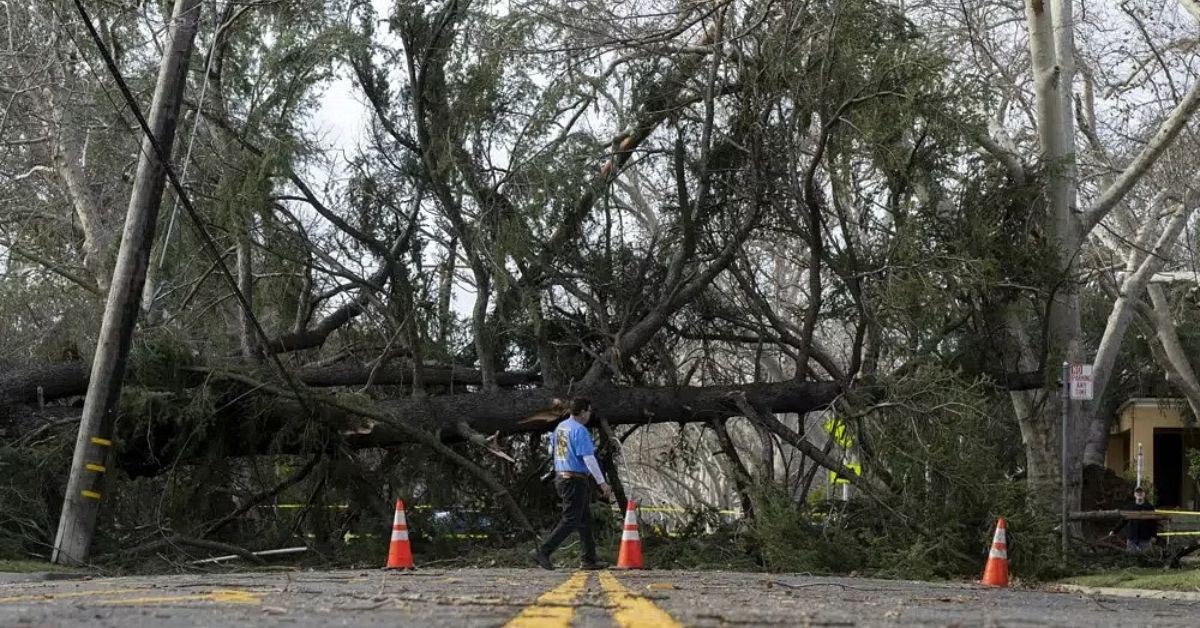SAN FRANCISCO (AP) — Sunday, storms, snow, and damaging winds hit the northern part of California. These storms came before another round of storms and made it more likely that roads would flood, rivers would rise, and mudslides would happen because the ground was already wet from days of rain.
The National Weather Service warned of a “nonstop parade of atmospheric rivers,” long plumes of moisture stretching out into the Pacific and dropping huge amounts of rain and snow.
The Sacramento Municipal Utility District said that as of Sunday evening, more than 60,000 customers were still without power in the state capital, down from more than 350,000. This was because trees were blown into power lines by winds of up to 60 mph (97 kph).

Joey Kleemann was listening to the wind howl shortly after midnight and wondering if she should move her car when she heard a “huge, thumping, crashing sound.” A huge tree had fallen on her Sacramento home, where she had lived for 25 years.
The winds were strong enough to pull the tree up by its roots, taking the concrete sidewalk with it. Because Kleemann’s roof had cracks, rain poured into her dining room all night. She was going to put a tarp over the damaged area in case it rained again.
Latest News
“The winds just gave me a feeling. “Those winds were scary,” she said. “I mostly thought, ‘It could be a lot worse.'”
Gov. Gavin Newsom said that in the past 10 days, 12 people died because of bad weather, and he warned that this week’s storms could be even worse. He told everyone to stay inside. “Just be careful over the next week, especially over the next day or two,” Newsom told California officials during a briefing about how the state was getting ready for the storm.
The Sacramento office of the National Weather Service said that the area should get ready for the latest atmospheric river to roar onto the coast late Sunday or early Monday.
The office said on Twitter that there could be a lot of downed trees, power outages, and hard driving conditions. About 13,000 people in a flood-prone area of Sonoma County north of San Francisco were told to leave because the Russian River was expected to spill over its banks in the next few days.
People living in and around Wilton, about 6,000 people about 20 miles southeast of downtown Sacramento, were told to leave because flooding was coming soon. During a storm, the area along the Cosumnes River in the country was flooded.
The county said, “People must leave before the roads become impassable.”
The state Department of Transportation told drivers to stay off mountain roads after a section of U.S. 395 along the Eastern Sierra in Mono County was closed because of heavy snow, ice, and whiteout conditions.
“Because this storm is so bad, Caltrans is asking all drivers to limit travel that isn’t necessary until the storm’s peak,” the department said. The rainy weather comes after days of rain in California caused by Pacific storms that killed at least six people, cut power to thousands, flooded streets, and beat up the coast last week.
The first of the new, stronger storms caused the weather service to issue a flood watch for a large part of Northern and Central California. The foothills around Sacramento, which are already very wet, are expected to get 6 to 12 inches (15 to 30 centimeters) of rain through Wednesday.
In the Los Angeles area, there was scattered rain over the weekend, and stormy weather was expected to return on Monday. Foothill areas could get up to 8 inches (20 cm) of precipitation. Waves would be big on west-facing beaches until Tuesday when the surf would be high. Since December 26, San Francisco has rained more than 10 inches (25 centimeters), while a popular ski area in the Eastern Sierra, Mammoth Mountain, got almost 10 feet (3 meters) of snow.
Even though the storms have helped, they won’t be enough to end the drought in California.
At a news briefing late Saturday night, state climatologist Michael Anderson said that officials were keeping a close eye on Monday’s storm and the one behind it. They were also keeping an eye on three other systems in the Pacific.
Stay tuned to our website NogMagazine.com for more updates.